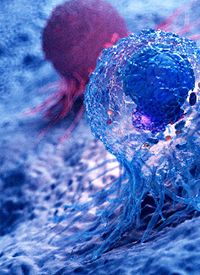Article
Press Release
Expanding the Patient Pool for Immunotherapies
Author(s):
Although immune checkpoint inhibitors can yield dramatic results and give some patients many years of life, some patients do not yield benefit.
stock.adobe.com

A patient’s response to immunotherapy is hard to predict.
One common class of immunotherapy drugs, immune checkpoint inhibitors, can yield dramatic results and give some patients many years of life. But most patients are not helped at all by such drugs.
Cancer researchers are working on ways to identify which patients are likely to respond to immunotherapy and improve the odds of success. Researchers at the Sylvester Comprehensive Cancer Center, part of the University of Miami Miller School of Medicine, and collaborating institutions are edging closer to this goal.
In a new study, the researchers molecularly profiled tumors, cataloging them into seven immune subtypes. One subtype appears to be particularly sensitive to immunotherapy drugs, they report in the Feb. 14 issue of the journal Cell.
The study aims to “better understand the immunological features of tumors, to provide insight into why some patients respond to immunotherapy and why others do not, and to identify new therapeutic targets,” said Michele Ceccarelli, a University of Miami professor of computational oncology who co-led the study.
The new findings could lead to ways to predict which patients are good candidates for immunotherapy, routinely. The data could also lead to new treatments to nudge tumors into a state that makes them responsive to such therapy.
Using Big Data to Analyze Tumors
Cells are each filled with millions of biological molecules, from DNA to RNA to protein. Scientists have previously cataloged the RNA in various tumors, which is a readout of which genes are active. But the tumor proteome, the set of proteins in tumors and their amounts, is the next frontier. Proteins do the heavy lifting in cells, regulating everything from growth to replication.
Methods to collect proteomic information have been refined over the years and there is a growing body of databases. A project supported by the National Cancer Institute has generated data from more than 1,000 tumor samples across 10 types of solid tumors, from lung cancer to breast cancer to colon cancer. The project includes a catalog of the proteins and RNAs present in each tumor sample, as well as additional molecular information.
Research groups have been sifting through the vast CPTAC datasets to find meaning in them.
Ceccarelli and his team brought their expertise in extracting immunological information from biological datasets. They had previously developed a computational method to assess the immunological features of tumors through an analysis of the RNA and proteins.
The researchers deployed their method on the CPTAC datasets and integrated information from others. They leveraged data from RNA profiles and the proteome and incorporated data on DNA and the regulatory “epigenetic” modifications of DNA, as well as the “phosphate groups” that can turn proteins on or off.
The amount of information was immense. But in the end, the scientists made sense of it, providing a readout of how all these molecular factors interact to shape the characteristics of the immune microenvironment of tumors.
The researchers found they could separate tumors into seven immune subtypes based on their molecule profiles. Each subtype contained a different set of immune cells and molecules.
One of these subtypes tracked with an improved patient response to therapy with an immune checkpoint inhibitor. This “immune hot” tumor subtype was present across all 10 cancer types.
Organizing Patients by Tumor Subtype
The study’s findings will inform future clinical trials, said Antonio Iavarone, M.D., deputy director of Sylvester and co-author of the study. He anticipates that he and his colleagues will stratify patients by tumor subtype and assess their responses to different immunotherapies.
Dr. Iavarone credits Sylvester’s “team science culture” with pulling together the dozens of institutions involved in the study. Ceccarelli co-led the study with Pei Wang, Ph.D., a genetics and genomic sciences professor at Icahn School of Medicine at Mount Sinai.
“We also have built tremendous computational infrastructure, instrumental in allowing the most sophisticated and state-of-the-art analyses,” added Dr. Iavarone, also a professor of neurological surgery and biochemistry and molecular biology at the Miller School.
Computer Vision, AI Drive Analysis
Despite the promise of the new findings, it’s not yet feasible to analyze tumor molecules at the scale needed to routinely assess tumor immune subtypes. But the data hinted at one way forward—analyzing the histology of samples of the tumor on microscope slides.
The research group used computer vision and artificial intelligence to analyze histology data from the CPTAC dataset and correlate it with immune subtypes. They found the approach could identify visual elements in histology slides that tracked with the subtype.
In the future, histology samples could potentially be routinely scanned by computer vision to assess the potential response of patients to immunotherapy, said Ceccarelli.
Turning “Immune Cold” Tumors Hot
Scientists are also working on ways to tweak “immune cold” tumors and turn them into “immune hot” tumors that respond to immunotherapy.
In the new study, the researchers emerged with several potential targets for tumor-tweaking drugs. Potential targets include proteins that become activated in “immune hot” tumors via phosphate groups identified in the data analysis.
Ceccarelli and his team are now returning such information to the lab to explore ways to make tumors susceptible to immunotherapy. He envisions that, one day, patients may first be treated with a drug that makes their tumor “immune hot,” followed by immunotherapy, in a one-two punch against cancer.





